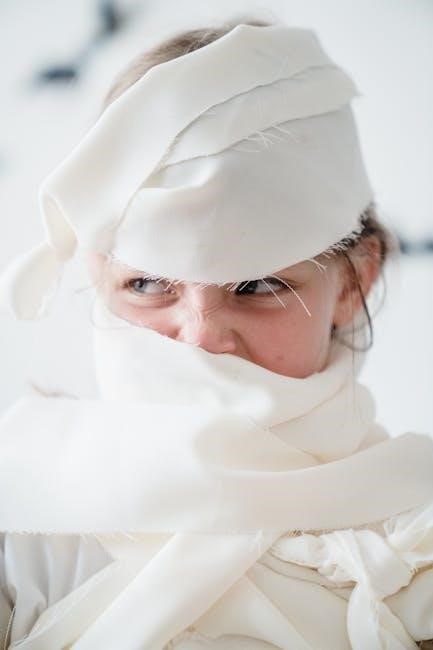
apivar strips instructions
Apivar strips are a popular and effective method for controlling Varroa mites in honeybee colonies․ They contain active ingredients that kill mites, helping maintain healthy bee populations and prevent colony loss․

What Are Apivar Strips?
Apivar strips are a treatment product for controlling Varroa mites in beehives․ They contain Amitraz, an acaricide that kills mites, and are designed for easy use by beekeepers․
2․1 Definition and Purpose
Apivar strips are a chemical treatment designed to control Varroa mite infestations in honeybee colonies․ These strips contain the active ingredient Amitraz, an acaricide that effectively kills Varroa mites․ Their primary purpose is to reduce mite populations, which are a significant threat to bee health and colony productivity․ By eliminating mites, Apivar strips help prevent diseases and maintain the overall well-being of the hive․ Beekeepers widely use them due to their simplicity and effectiveness․ The strips are placed directly in the brood chamber, where they release the active ingredient as bees come into contact with them․ This method ensures prolonged exposure, maximizing the treatment’s efficacy․ Apivar strips are a crucial tool for sustainable beekeeping practices, aiming to protect colonies and ensure healthy honey production․ Regular use, as part of an integrated pest management strategy, helps safeguard bee populations from the devastating impact of Varroa mites․
2․2 Composition and Functionality
Apivar strips are composed of a polymer matrix impregnated with the active ingredient Amitraz, an acaricide specifically designed to target Varroa mites․ The strips are formulated to release Amitraz slowly over time, ensuring prolonged exposure for the mites․ This controlled release mechanism maximizes the treatment’s effectiveness while minimizing potential harm to the honeybees․ When placed in the hive, the strips are suspended between frames in the brood chamber, allowing bees to come into contact with both sides of the strip․ As the bees move around the hive, they transfer the Amitraz to other bees and mites through contact, effectively reducing the mite population․ The polymer material ensures durability and consistent release of the active ingredient, making the strips a reliable and efficient solution for Varroa mite control․ This composition and functionality make Apivar strips a popular choice among beekeepers for maintaining healthy colonies․

How to Use Apivar Strips
Apivar strips are hung between frames in the brood chamber, ideally in areas of high bee activity․ Use 2 strips per brood chamber and leave them for 6-10 weeks․
3․1 When to Apply
Apivar strips should be applied when Varroa mite levels are high, typically during the spring before nectar flow begins and again in the fall after honey harvesting․ This ensures optimal mite control without interfering with honey production․ The strips are most effective when placed in the brood chamber, where mite activity is highest․ It’s important to remove supers before application to prevent contamination of honey products․ Treatments should be applied for 6-10 weeks, depending on the size of the brood․ Avoid using Apivar strips during active honey flow, as this can lead to residue in honey․ Proper timing is crucial for maximizing effectiveness and maintaining hive health․ Always follow the manufacturer’s guidelines for application timing to ensure safe and successful treatment․
3․2 Where to Place in the Hive
Apivar strips should be placed in the brood chamber, where Varroa mite activity is highest․ Hang the strips between frames in areas of high bee activity, ensuring bees can access both sides․ Suspend them at least 2 frames apart to maximize coverage․ For optimal effectiveness, use 2 strips per brood chamber, positioning them near the cluster’s edge․ In nuclei, 1 strip is sufficient․ Ensure the strips are not touching the frames or each other, as this can reduce their effectiveness․ Proper placement allows bees to walk on both sides, ensuring even distribution of the active ingredients․ Always follow the manufacturer’s guidelines for placement to achieve the best results and maintain hive health․ Correct positioning is critical for maximizing mite control and minimizing potential disruptions to the colony․
3․3 Number of Strips per Hive
The recommended number of Apivar strips per hive is 2 strips per brood chamber, ensuring optimal coverage and effectiveness․ For smaller colonies or nuclei, 1 strip is sufficient․ Place the strips between frames in the brood chamber, spaced at least 2 frames apart, to ensure even distribution of the active ingredients․ This configuration allows bees to come into contact with the strips on both sides, maximizing the treatment’s efficacy․ The number of strips should be adjusted based on the size of the hive and the severity of the mite infestation․ Always follow the manufacturer’s guidelines to avoid under- or over-treatment․ Proper strip placement and quantity are crucial for successful Varroa mite control and maintaining the health of the hive․ Ensure strips are not overcrowded, as this can hinder their performance․
3․4 Application Process
The application of Apivar strips is straightforward but requires careful attention to detail․ Begin by removing any supers from the hive to ensure the strips are placed where bee activity is highest․ Separate the double strips if necessary, as each strip is designed for individual use․ Hang each strip between two frames in the brood chamber, ensuring it is suspended in a way that allows bees to access both sides․ For hives with multiple brood chambers, apply the recommended number of strips to each chamber․ Avoid touching the strips excessively, as oils from human skin can reduce their effectiveness․ Once applied, close the hive and allow the bees to interact with the strips naturally․ The strips should remain in the hive for the recommended duration, typically 6 to 10 weeks, depending on the brood size․ Always follow the manufacturer’s instructions for proper application․

Treatment Duration and Frequency
Apivar strips should remain in the hive for 6 to 10 weeks, depending on brood size․ Apply twice a year: spring before nectar collection and autumn after harvesting․
4․1 How Long to Leave Strips in the Hive
Apivar strips should remain in the hive for 6 to 10 weeks, depending on the brood size․ Larger broods require a longer treatment period to ensure effectiveness․ The strips are typically applied twice a year, once in the spring before nectar collection begins and once in the autumn after harvesting․ This timing helps target mite populations when they are most active and avoids interference with honey production․ It’s important not to leave the strips in the hive for more than 10 weeks, as prolonged use can lead to mite resistance․ Always follow the manufacturer’s guidelines to ensure optimal results and minimize risks to the colony․ Proper timing and duration are critical for maintaining healthy bees and preventing Varroa infestations․
4․2 Recommended Treatment Frequency
Apivar strips should be used twice a year for optimal Varroa mite control․ The first treatment is recommended in the spring, before the bees begin nectar collection, and the second in the autumn, after the honey harvest․ This schedule targets mite populations when they are most active and helps prevent infestations from building up․ It’s important to avoid using Apivar strips more frequently than recommended, as overuse can lead to mite resistance․ Consistency in treatment timing is key to ensuring the health of the colony and preventing potential issues․ Always follow the manufacturer’s guidelines for application frequency to maximize effectiveness and safety for the bees․ Proper timing prevents overexposure and ensures the strips remain a reliable tool in mite management․

Safety Precautions
When using Apivar strips, wear gloves, safety glasses, and a veil to protect yourself from potential chemical exposure․ Avoid direct contact with the strips and follow all manufacturer guidelines to ensure safe application and hive protection․
5․1 Personal Protective Equipment
When handling Apivar strips, it is essential to wear appropriate personal protective equipment (PPE) to minimize exposure to the active ingredients․ This includes gloves to prevent skin contact, a veil to protect the face and neck, and safety glasses to shield the eyes from potential irritation․ Additionally, wearing long sleeves and protective clothing can further reduce the risk of exposure․ Avoid eating, drinking, or smoking while applying the strips․ After handling the strips, wash hands thoroughly with soap and water․ Properly dispose of any contaminated PPE to prevent cross-contamination․ Following these precautions ensures the safety of both the beekeeper and the hive․ Always refer to the manufacturer’s guidelines for specific recommendations on PPE use․ Proper safety measures help prevent unnecessary risks and ensure effective treatment of the hive․
5․2 Ensuring Hive Safety
To ensure hive safety while using Apivar strips, proper application and monitoring are crucial․ Always remove supers before applying the strips to prevent contamination of honey products․ Strips should be hung in the brood chamber, away from direct contact with honeycomb intended for honey collection․ Avoid placing strips in areas where bees are not actively present, as this can reduce effectiveness and potentially harm the colony․ Regularly inspect the hive to ensure strips are not causing unintended damage or disrupting bee activity․ Do not leave strips in the hive longer than the recommended 6-8 weeks, as prolonged exposure can lead to residue buildup․ Properly dispose of used strips to prevent environmental contamination․ Following these guidelines helps maintain a healthy and safe environment for your bees while effectively controlling mite populations․ Hive safety is paramount to ensure the well-being of the colony and the success of the treatment․

Effectiveness of Apivar Strips
Apivar strips are highly effective in controlling Varroa mites, a major threat to honeybee colonies․ They significantly reduce mite populations, helping to prevent colony decline and promote healthy bee activity․
6․1 Success Rates in Mite Control
Apivar strips have demonstrated high success rates in controlling Varroa mite infestations, significantly reducing mite populations within honeybee colonies․ Studies and beekeeper experiences show that when used correctly, Apivar strips can eliminate up to 90% of mites, effectively preventing colony loss․ The active ingredients in the strips work through contact, ensuring that mites are targeted as bees move around the hive․ Proper application and timing, such as treating twice a year during spring and fall, enhance the product’s efficacy․ Beekeepers report improved colony health and reduced mite-related issues after using Apivar strips․ However, success depends on adherence to instructions, such as avoiding overuse and ensuring strips are left in the hive for the recommended 6-10 weeks․ This consistent effectiveness makes Apivar strips a trusted tool in beekeeping for mite control․
6․2 Factors Influencing Effectiveness
The effectiveness of Apivar strips can be influenced by several factors, including proper application timing, the number of strips used, and their placement within the hive․ Ensuring strips are hung in areas of high bee activity, such as the brood chamber, maximizes contact with mites․ The recommended treatment duration of 6-10 weeks is critical, as shorter periods may not fully eliminate mite populations․ Overuse of strips can lead to mite resistance, reducing long-term efficacy․ Hive size and strength also play a role, with larger colonies requiring more strips to achieve optimal results․ Adhering to the manufacturer’s guidelines, such as using 2 strips per brood chamber, is essential for success․ Environmental conditions, like temperature and nectar flow, can impact treatment performance, but Apivar strips remain highly effective when used correctly․ Proper monitoring and follow-up treatments further enhance their effectiveness in maintaining healthy bee colonies․

Common Mistakes to Avoid
Overusing Apivar strips can lead to mite resistance, while incorrect placement or insufficient treatment duration may reduce effectiveness․ Always follow guidelines to avoid these common errors․
7․1 Overuse of Strips
Overusing Apivar strips can lead to Varroa mite resistance, reducing their long-term effectiveness․ It is crucial to avoid using the strips every time mites are detected, as this can harm the colony and the environment․ Instead, apply the strips only when mite levels exceed the recommended threshold, typically twice a year—once in spring and once in autumn․ Leaving the strips in the hive for the recommended 6-8 weeks ensures optimal results without overexposing the bees․ Always adhere to the manufacturer’s guidelines to prevent misuse and maintain the product’s efficacy․ Overuse can also lead to chemical buildup in the hive, potentially harming the bees and contaminating honey․ Proper monitoring and timely application are key to successful treatment․ Avoiding overuse ensures the health of your colony and the sustainability of your beekeeping practices․
7․2 Incorrect Placement
Incorrect placement of Apivar strips can significantly reduce their effectiveness and potentially harm the colony․ Strips should always be hung in the brood chamber, where bee activity is highest, ensuring bees can walk on both sides․ Placing strips in the supers or outside the brood area reduces contact with the mites and bees, lowering efficacy․ Additionally, strips should not be overcrowded; maintain a minimum distance of two frames between strips to allow proper airflow and bee movement․ Incorrect suspension, such as laying strips flat or failing to hang them securely, can also lead to uneven distribution of the active ingredients․ Always follow the manufacturer’s guidelines for placement to ensure optimal mite control and protect the health of your colony․ Proper placement is essential for maximizing the strips’ effectiveness and safeguarding your bees․

Monitoring and Follow-Up
Regular monitoring after applying Apivar strips is crucial to ensure treatment success․ Check mite levels post-treatment and take necessary actions based on the results to maintain colony health․
8․1 Checking Mite Levels Post-Treatment
Monitoring mite levels after using Apivar strips is essential to assess treatment effectiveness․ Beekeepers should inspect the hive 2-3 weeks after application to ensure mites are being controlled․ One common method is visually inspecting the brood frames for signs of mite infestation or using a mite count tool like the Véto-pharmas EasyCheck monitor․ Bees should be actively walking on both sides of the strips, indicating proper use․ If mite levels remain high, additional actions may be necessary․ It’s also important to check again 6-8 weeks after removing the strips to confirm the treatment’s success․ Regular monitoring helps prevent re-infestation and ensures the health of the colony․ Always follow up with additional treatments if mite populations rebound, as specified in the manufacturer’s guidelines․ This step ensures the long-term health and productivity of the hive․
8․2 Necessary Follow-Up Actions
After checking mite levels post-treatment, beekeepers must take appropriate follow-up actions․ If mite levels remain high, repeat the Apivar treatment as per the manufacturer’s instructions, ensuring not to exceed the recommended frequency․ Additionally, consider integrating other control methods, such as screen bottom boards or drone brood removal, to enhance effectiveness․ It’s crucial to maintain good hive hygiene by clearing debris and dead bees․ Regular inspections of brood frames for signs of disease or infestation are essential․ Beekeepers should also monitor for any adverse effects on the bees, such as excessive mortality or behavior changes, and adjust treatments accordingly․ Ensuring the hive’s overall health through proper nutrition and management practices is vital․ Follow-up actions should always be guided by the specific needs of the colony and the results of post-treatment monitoring․ This comprehensive approach helps sustain a healthy, thriving hive․

Troubleshooting Common Issues
Apivar strips may occasionally face issues like reduced effectiveness or improper placement․ Addressing these promptly ensures optimal mite control and hive health․
9․1 When Strips Are Not Effective
Apivar strips may not work as expected due to incorrect placement, insufficient number of strips, or improper timing․ If the strips are not hung in areas of high bee activity or left in the hive for the recommended 6-10 weeks, effectiveness decreases․ Overuse can lead to chemical resistance, reducing long-term efficacy․ Ensure strips are placed between frames in the brood chamber and avoid using them during honey flow․ Monitor mite levels post-treatment to assess effectiveness․ If issues persist, consider alternative treatments or consult a beekeeping expert․ Always follow manufacturer guidelines to maximize results․ Regular monitoring and proper application are key to successful mite control․
9․2 Addressing Other Potential Problems
Besides ineffectiveness, other issues may arise when using Apivar strips․ Improper handling, such as tearing the strips, can reduce their efficacy․ Leaving strips in the hive beyond the recommended 6-10 weeks may lead to residue buildup․ Overuse can contribute to chemical resistance in mite populations․ Bees may avoid strips if placed incorrectly or in low-activity areas; Ensure strips are hung securely between frames in the brood chamber․ Replace strips as needed to maintain potency․ If mites persist, rotate treatments to avoid resistance․ Monitor bee behavior and hive health during treatment․ Follow manufacturer guidelines for application and removal․ Regular inspections can help identify issues early․ Addressing these problems promptly ensures the strips remain a reliable tool in mite control․ Proper use and maintenance are key to achieving desired results․

Additional Resources
For further guidance, refer to tutorial videos and manufacturer guidelines․ These resources provide detailed instructions and tips for optimal Apivar strip usage, ensuring successful mite control and hive health․
10․1 Tutorial Videos and Guides
Tutorial videos and guides are excellent resources for beekeepers to learn how to use Apivar strips effectively․ These videos demonstrate step-by-step instructions, including proper placement, timing, and dosage․ For example, Veto-pharma, the manufacturer, has released a revised tutorial video featuring Freddy Proni, showcasing the correct application process at their apiary in Chaillac, France․ Additionally, there are videos explaining how to monitor mite levels and when to apply treatments․ Guides often include tips for avoiding common mistakes, such as overuse or incorrect placement․ These resources emphasize the importance of following instructions to ensure both hive safety and treatment effectiveness․ By watching these tutorials, beekeepers can gain confidence in using Apivar strips to protect their colonies from Varroa mites․ Always refer to the most recent guides and videos for updated best practices and product information․
10․2 Manufacturer Guidelines
Manufacturer guidelines for Apivar strips are essential for ensuring safe and effective use․ Veto-pharma, the producer, provides detailed instructions to help beekeepers achieve optimal results․ The guidelines recommend applying Apivar strips in the spring before nectar collection and in the fall after harvesting․ Each brood chamber should have 2 strips, placed between frames in the brood area, ensuring bees can access both sides․ Strips should remain in the hive for 6 to 10 weeks, depending on brood size․ It’s crucial to avoid using Apivar for every mite treatment to prevent resistance․ The manufacturer also advises against using the strips during honey supers to avoid contamination․ Always follow the instructions for proper handling, such as wearing gloves, and ensure strips are removed after the recommended duration; Adhering to these guidelines ensures the health of the hive and the effectiveness of the treatment․
Apivar strips are a proven and effective solution for managing Varroa mite infestations in honeybee colonies․ By following the manufacturer’s guidelines and proper application techniques, beekeepers can significantly reduce mite populations, promoting healthier bees and preventing colony loss․ The strips are easy to use and provide a targeted treatment approach, making them a valuable tool for sustainable beekeeping practices․ It is essential to apply the strips during the recommended seasons—spring and fall—and to remove them after the specified duration to avoid residue buildup․ Regular monitoring and adherence to best practices ensure the long-term effectiveness of Apivar strips․ By incorporating this treatment into their hive management routine, beekeepers can help protect their colonies and contribute to the overall health of honeybee populations․ Always prioritize proper usage to maximize benefits and maintain a thriving apiary․